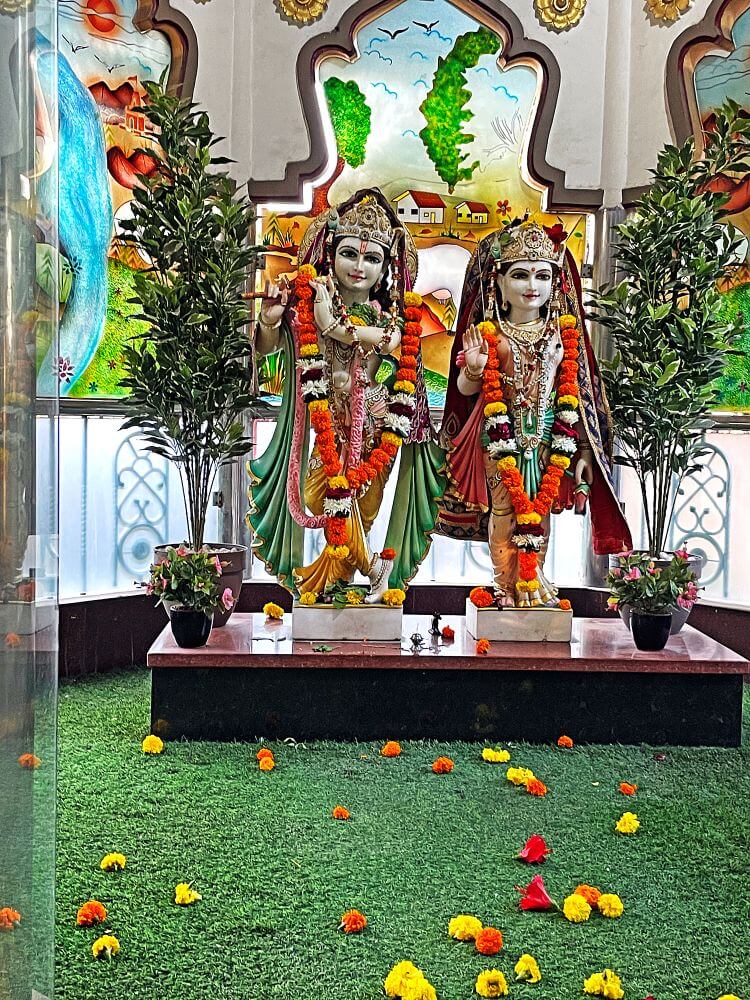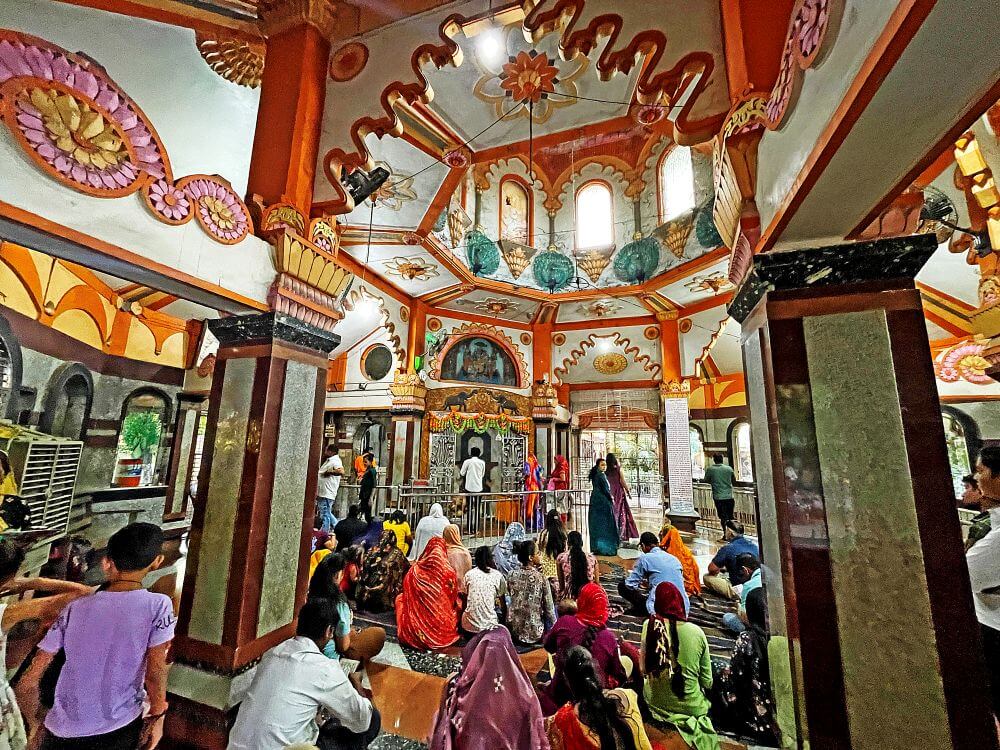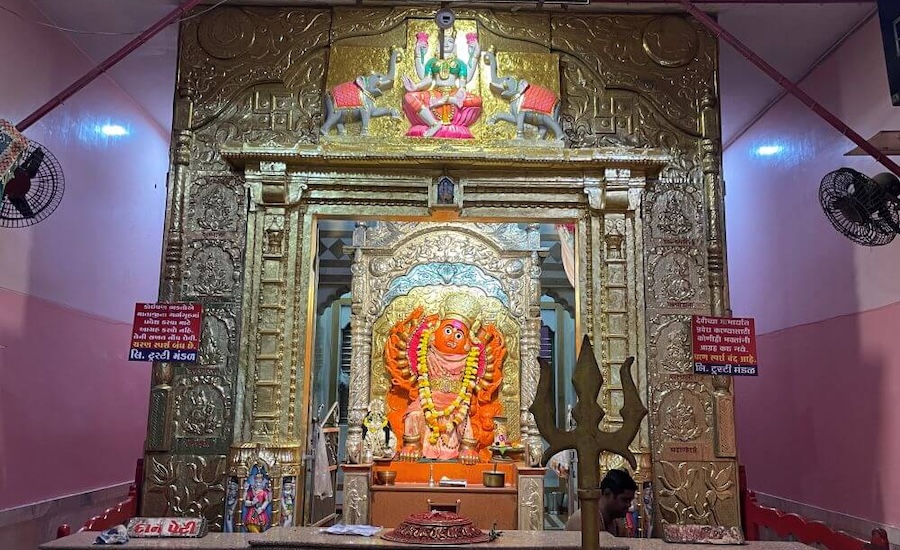 The Akalamukhi Hanuman Temple, located in Kadodara, is a revered site known for its unique and self-manifested idol of Hanuman in the rare Akalamukhi form. Devotees believe that this form of Lord Hanuman fulfills all wishes and offers blessings to those who visit. The temple witnesses a constant stream of visitors, especially during the month of Shravan on Saturdays, when the atmosphere resembles a vibrant fair due to the large gatherings.
The Akalamukhi Hanuman Temple, located in Kadodara, is a revered site known for its unique and self-manifested idol of Hanuman in the rare Akalamukhi form. Devotees believe that this form of Lord Hanuman fulfills all wishes and offers blessings to those who visit. The temple witnesses a constant stream of visitors, especially during the month of Shravan on Saturdays, when the atmosphere resembles a vibrant fair due to the large gatherings.
The name “Akalamukhi Hanuman” is said to have evolved from the Marathi name “Akara Mukhi Hanuman” (Eleven-Faced Hanuman). Over time, linguistic variations led to the current name. Temples dedicated to Hanuman in different forms, including Ekamukhi (One-Faced) and Panchmukhi (Five-Faced) Hanuman, are found across India. Panchmukhi Hanuman represents Hanuman with five faces: Hanuman, Narasimha, Garuda, Varahaand Hayagriva. The Akalamukhi or Eleven-Faced Hanuman includes Hanuman, Narasimha, Garuda, Varaha, Hayagriva, Nag, Rudra, Shri Ram, Agni, Ganeshand Bhairava.
A legend explains the origin of Hanuman’s eleven-faced form. According to the tale, a demon named Kalakar performed severe penance and pleased Lord Brahma. He requested immortality, but Brahma declined, granting instead that only someone with eleven faces, born on Kalakar’s birth date, could kill him.  Empowered by this boon, Kalakar began terrorizing the gods, who sought Lord Vishnu’s help. Vishnu advised them to approach Lord Ram. Ram revealed that Hanuman alone could defeat the demon. Following Ram’s directive, Hanuman assumed the eleven-faced form and vanquished Kalakar on his birthday, which falls on Chaitra Purnima (full moon day in the Chaitra month). This form of Hanuman is also known as Ekadash Roop (Eleven Forms).
Empowered by this boon, Kalakar began terrorizing the gods, who sought Lord Vishnu’s help. Vishnu advised them to approach Lord Ram. Ram revealed that Hanuman alone could defeat the demon. Following Ram’s directive, Hanuman assumed the eleven-faced form and vanquished Kalakar on his birthday, which falls on Chaitra Purnima (full moon day in the Chaitra month). This form of Hanuman is also known as Ekadash Roop (Eleven Forms).
The temple’s origins trace back to a saint who, according to local lore, consecrated the Akalamukhi Hanuman idol in response to hardships faced by the Kadodara region. While the precise history of the temple remains unknown, it is regarded as an ancient site. Over the years, renovations have transformed it into a beautiful blend of traditional and modern architectural styles.
The temple is situated on a large plot enclosed by tall boundary walls. The main entrance, constructed from red stone, features intricately carved designs. Shops selling offerings and devotional items flank the entrance. The grand gateway is crowned with a carved spire and a tall pinnacle. Smaller entryways are located on either side of the main gate. Inside the premises, a sheltered pathway for darshan (viewing the deity) lies to the right. A large circular fountain adorns the courtyard, flanked by circular shelters with seating arrangements for devotees.
 The main temple is built on an elevated plinth and comprises a mukhamandapa (entrance porch), a sabhamandapa (assembly hall), a garbhagriha (sanctum)and two subsidiary sanctums. The temple boasts four spires: two above the subsidiary sanctums, one above the sabhamandapaand the tallest atop the main sanctum. The primary spire is a hallmark of Nagara-style architecture, featuring ornate window-like designs (gawaksha) on all sides.
The main temple is built on an elevated plinth and comprises a mukhamandapa (entrance porch), a sabhamandapa (assembly hall), a garbhagriha (sanctum)and two subsidiary sanctums. The temple boasts four spires: two above the subsidiary sanctums, one above the sabhamandapaand the tallest atop the main sanctum. The primary spire is a hallmark of Nagara-style architecture, featuring ornate window-like designs (gawaksha) on all sides.
The spacious sabhamandapa is crowned with an octagonal dome adorned with painted depictions of various deities. At the center of the main sanctum, a unique self-manifested stone idol of Hanuman is installed in a circular hollow below ground level. The idol is painted in golden color, with one face adorned with a golden crown. Along the sanctum walls, a raised altar houses marble idols of Shri Ram, Lakshmanand Sita. The two subsidiary sanctums feature idols of Lord Shiva, Parvatiand Ganesh in the right sanctumand exquisite marble idols of Radha and Krishna in the left sanctum.
The temple complex includes a sacred yajna kunda (fire altar) where regular havans (fire rituals) and pujas are performed. In front of the temple stands an Om-shaped metallic lamp tower where devotees light lamps as an expression of faith. Special religious events are organised on Hanuman Jayanti, Ram Navamiand Mahashivratri. On Tuesdays and Saturdays, special aartis and bhajans are conducted. During Shravan Saturdays, the temple experiences a surge in devotees.



